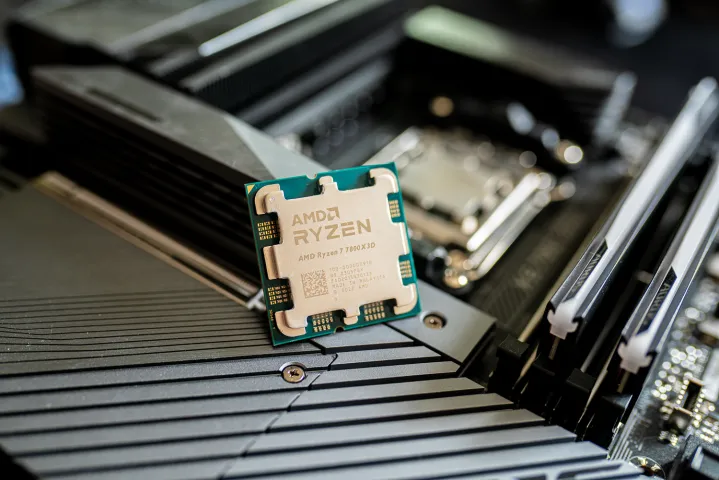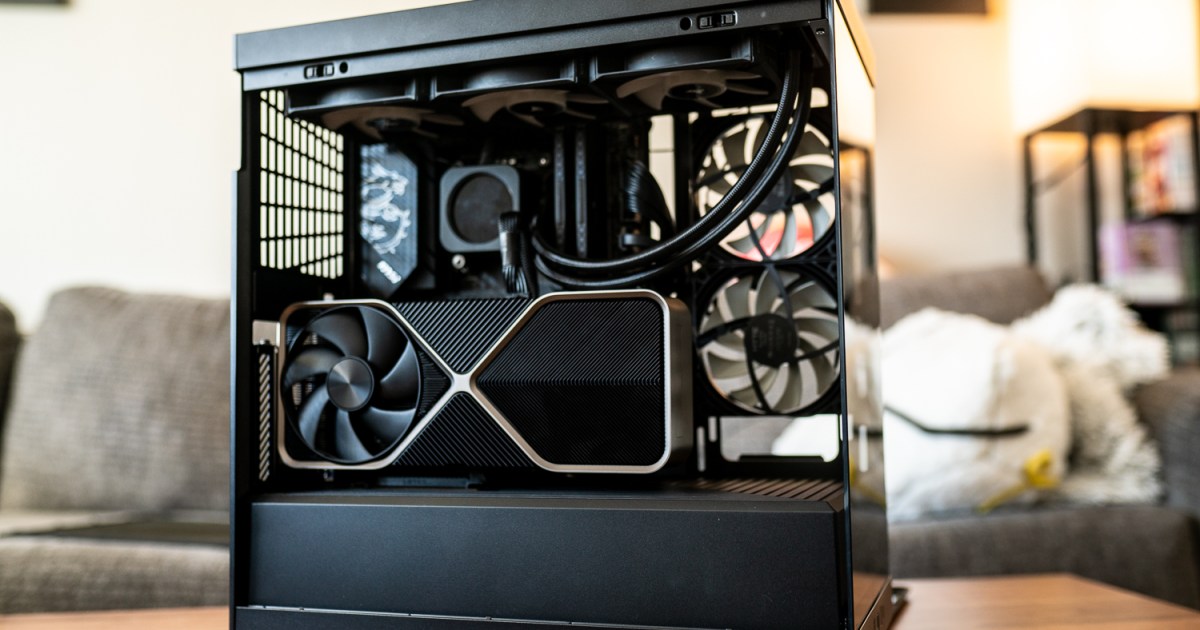Intel’s new Core Ultra 9 285K is finally here, promising a boost in performance with a significant reduction in power requirements, at least according to Intel. As you can read in my Core Ultra 9 285K review, Intel’s performance claims aren’t as rosy as reality, especially when stacked up against what is unequivocally the best processor for gaming you can buy: AMD’s Ryzen 7 7800X3D.
I threw both processors on the test bench to pit them head-to-head, looking at performance across productivity and gaming apps, as well as thermals and efficiency. These CPUs target different users, but there are still a lot of interesting comparisons we can look at between them.
Specs
 Jacob Roach / Digital Trends
Jacob Roach / Digital TrendsThe Core Ultra 9 285K and Ryzen 7 7800X3D are radically different CPUs, and that becomes clear when you compare their specs directly. Although it’s generally not a good idea to compare specs between two CPUs in the same class, the gap in specs here is so large that we can make some interesting observations. The main thing that’s different between the two CPUs is core count.
Get your weekly teardown of the tech behind PC gaming
The Ryzen 7 7800X3D is a fairly straightforward chip in that regard. It comes with eight Zen 4 cores and a total of 16 threads, and it can boost up to 5GHz. That’s not what’s interesting about the CPU. It’s the 104MB of cache packed on top of the CPU die, split between 8MB of L2 cache and 96MB of L3 cache thanks to AMD’s 3D V-Cache packaging tech.
| Core Ultra 9 285K | Ryzen 7 7800X3D | |
| Cores/Threads | 24/24 (8P+16E) | 8/16 |
| Boost clock speed | 5.7GHz | 5GHz |
| Base clock speed | 3.7GHz | 4.2GHz |
| Cache (L2 + L3) | 76MB | 104MB |
| TDP | 250W | 120W |
| Price | $589 | $450 |
The Core Ultra 9 285K doesn’t have any fancy 3D V-Cache, but it still has a few tricks of its own. It’s a 24-core CPU, but unlike the Ryzen 7 7800X3D, it doesn’t come with simultaneous multi-threading (SMT). Each core only has a single thread. In addition, Intel uses its hybrid architecture, mixing together the Lion Cove P-core design with the Skymont E-core design. According to Intel, the E-cores are the main performance drivers here, unlike with the Core i9-14900K, where the E-cores were relatively weak.
With more cores and higher clock speeds, it shouldn’t come as a surprise that the Core Ultra 9 285K has much higher power requirements. I’ll address efficiency directly a bit lower down in this comparison, but I can tell you now that, under a full load, the Core Ultra 9 285K indeed draws twice as much (or more) power than the Ryzen 7 7800X3D — though usually with much better performance.
Pricing
 Jacob Roach / Digital Trends
Jacob Roach / Digital TrendsThe Core Ultra 9 285K and Ryzen 7 7800X3D force you to think about pricing because, depending on what you’re using your PC for, you can save quite a bit of money. The Core Ultra 9 285K is newer, and it’s the flagship chip from Intel’s latest range, so you’ll spend $589 if you want to pick it up now. The price will drop over time — the Core i9-14900K is about $450 a year after releasing — but until we see the next generation from Intel, you can expect to spend over $500.
The Ryzen 7 7800X3D is much cheaper at $450, though I’ve seen some strange price shifts with the CPU over the past several months. Just a few weeks before publishing this comparison, the Ryzen 7 7800X3D was sold out everywhere, and prior to that, you could commonly find it for around $320. Now, at the time of publishing, you’ll find it between $450 and $500, but I expect the price will drop very soon.
AMD has confirmed that its next-gen 3D V-Cache CPU is arriving on November 7, so depending on when you’re reading this, make sure to check in on the price of the Ryzen 7 7800X3D. If the new CPU is out by then, I expect we’ll see the price drop to around $350 to $400.
Even with its higher price, the Ryzen 7 7800X3D is significantly cheaper than the Core Ultra 9 285K — $139 cheaper, at least, and close to $239 cheaper if the Ryzen 7 7800X3D drops in price.
Productivity performance
 Jacob Roach / Digital Trends
Jacob Roach / Digital TrendsHere’s some quick proof that the Core Ultra 9 285K and Ryzen 7 7800X3D are in completely different weight classes. As you can see from Cinebench R24 above, the Core Ultra 9 285K is much faster than the Ryzen 7 7800X3D — it’s not even close. Intel says this CPU is particularly strong in a ray-traced renderer line Cinebench, but even if you dropped 10% or 15% of the performance from the Core Ultra 9 285K, it would still be miles ahead of the Ryzen 7 7800X3D.
 Jacob Roach / Digital Trends
Jacob Roach / Digital TrendsFor more of a mixed-use benchmark, take a look at Geekbench 6. The Core Ultra 9 285K still runs away with multi-core performance, but the single-core delta is much smaller. And despite the clear lead in multi-core performance, that gap is smaller, too. Throughout my testing, one thing became clear — the Core Ultra 9 285K is really fast in certain applications, but that performance doesn’t apply everywhere.
 Jacob Roach / Digital Trends
Jacob Roach / Digital TrendsA great example of that is Photoshop. You’d assume that the raw multi-core advantage of the Core Ultra 9 285K would mean it obviously wins against the Ryzen 7 7800X3D, but that’s not the case. In fact, the Ryzen 7 7800X3D is faster in Photoshop based on my testing. That’s not good considering the price and spec gap between these two CPUs. You’d expect the Core Ultra 9 285K to mop the floor with the Ryzen 7 7800X3D across all productivity applications.
 Jacob Roach / Digital Trends
Jacob Roach / Digital TrendsIn Premiere Pro, the Core Ultra 9 285K reclaims a dominant spot, but it really shouldn’t be this close. Not only is the Core Ultra 9 285K a much more capable CPU, it also has access to QuickSync in Premiere Pro, which speeds up performance significantly. The fact that these two CPUs are even competitive in Premiere shows how the performance of the Core Ultra 9 285K can be disappointing in certain apps.
Gaming performance
 Jacob Roach / Digital Trends
Jacob Roach / Digital TrendsGaming performance is where we see a more consistent divergence. The Ryzen 7 7800X3D crushes. Across the 10 games I tested, the Ryzen 7 7800X3D didn’t lose a single one. Sometimes it’s only showing a minor performance improvement, but in games like F1 22 and Cyberpunk 2077, the Ryzen 7 7800X3D provides a transformative uplift in gaming performance.
Not all games respond well to the additional cache on the Ryzen 7 7800X3D. As you can see from titles like Assassin’s Creed Mirage and Black Myth: Wukong, there’s some other factor limiting the performance of the processor — in most cases, your graphics card. However, other games can leverage the additional cache in quite a big way, as shown off by Final Fantasy XIV, Tiny Tina’s Wonderlands, and even Red Dead Redemption 2.
For the Core Ultra 9 285K, it can only hope to match the Ryzen 7 7800X3D, and in most games, it’s not even close to doing that. If you’re focused mainly on gaming, there’s really no contest here. The Ryzen 7 7800X3D absolutely crushes the Core Ultra 9 285K, and it’s significantly cheaper.
Thermals and efficiency
 Jacob Roach / Digital Trends
Jacob Roach / Digital TrendsAnother area where the Ryzen 7 7800X3D leads is efficiency. It not only has much lower rated power, it can also deliver higher performance in games while consuming less power. You can see that in action in the chart above. Looking solely at peak power draw during these games, the Ryzen 7 7800X3D stayed much more efficient under a heavy workload.
That’s not be critical of Intel. As you can see from the Core i9-14900K, Intel made massive efficiency improvements this generation, and it’s often able to deliver similar performance under 100 watts. But it’s still more power than the Ryzen 7 7800X3D, which rarely goes above 50 watts in games.
 Jacob Roach / Digital Trends
Jacob Roach / Digital TrendsTemperature is a different story. On average, the Core Ultra 9 285K was a bit cooler than the Ryzen 7 7800X3D while playing games. It’s not a massive difference, but I tested with a 360mm all-in-one liquid cooler. In a small form factor PC, those temperature differences can really add up, and the Core Ultra 9 285K is set up to handle a more thermally constrained environment better.
It’s important to remember the design of 3D V-Cache CPUs. The cache is stacked directly on top of the cores, serving as an insolating layer between the cores and the integrated heat spreader (IHS). That’s why the Ryzen 7 7800X3D, and other 3D V-Cache CPUs, tend to run a bit hotter and why they aren’t unlocked for overclocking.
The gaming king reigns supreme
 Jacob Roach / Digital Trends
Jacob Roach / Digital TrendsThere’s really no contest here if you’re a gamer — the Ryzen 7 7800X3D is the way to go. It’s much faster, and it’s cheaper, and although productivity performance lags, the CPU still puts up a surprisingly impressive fight in apps like Premiere Pro and Photoshop.
The natural counter to that is productivity performance. If that’s what you care about, the Core Ultra 9 285K is the way to go. However, the inconsistent performance I saw with Intel’s latest CPU is worth keeping in mind. If you want good productivity performance and gaming in equal stride, I’d push you toward Intel’s Core i9-14900K or AMD’s latest Ryzen 9 9950X instead, the former of which is available for around $450.





















 English (US) ·
English (US) ·